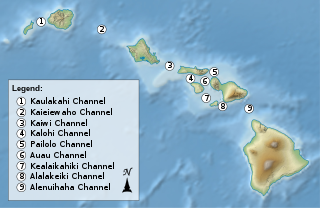
In an archipelago like the Hawaiian Islands the water between islands is typically called a channel or passage. Described here are the channels between the islands of Hawaiʻi, arranged from northwest to southeast.
Aiea or ʻAiea may refer to:
Located about 2300 miles (3680 km) from the nearest continental shore, the Hawaiian Islands are the most isolated group of islands on the planet. The plant and animal life of the Hawaiian archipelago is the result of early, very infrequent colonizations of arriving species and the slow evolution of those species—in isolation from the rest of the world's flora and fauna—over a period of at least 5 million years. As a consequence, Hawai'i is home to a large number of endemic species. The radiation of species described by Charles Darwin in the Galapagos Islands which was critical to the formulation of his theory of evolution is far exceeded in the more isolated Hawaiian Islands.
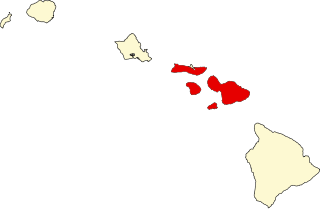
Maui Nui is a modern geologists' name given to a prehistoric Hawaiian island and the corresponding modern biogeographic region. Maui Nui is composed of four modern islands: Maui, Molokaʻi, Lānaʻi, and Kahoʻolawe. Administratively, the four modern islands comprise Maui County. Long after the breakup of Maui Nui, the four modern islands retained plant and animal life similar to each other. Thus, Maui Nui is not only a prehistoric island but also a modern biogeographic region.

Pritchardia remota, the Nihoa pritchardia, Nihoa fan palm, or Loulu, is a species of palm endemic on the island of Nihoa, Hawaiʻi, and later transplanted to the island of Laysan. It is a smaller tree than most other species of Pritchardia, typically reaching only 4–5 metres (13–16 ft) tall and with a trunk diameter of 15 centimetres (5.9 in). It is the only type of tree on the island and used to be abundant. In 1885 a wildfire ravaged the island, destroying most of the palms. Only about 700 of these trees remain, making the species endangered but numbers are slowly increasing. The palm is being cultivated in botanical gardens.
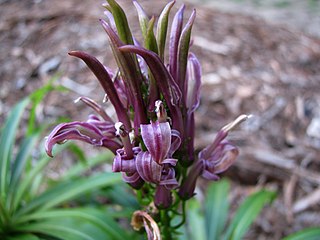
The Hawaiian lobelioids are a group of flowering plants in the bellflower family, Campanulaceae, subfamily Lobelioideae, all of which are endemic to the Hawaiian Islands. This is the largest plant radiation in the Hawaiian Islands, and indeed the largest on any island archipelago, with over 125 species. The six genera involved can be broadly separated based on growth habit: Clermontia are typically branched shrubs or small trees, up to 7 metres (23 ft) tall, with fleshy fruits; Cyanea and Delissea are typically unbranched or branching only at the base, with a cluster of relatively broad leaves at the apex and fleshy fruits; Lobelia and Trematolobelia have long thin leaves down a single, non-woody stem and capsular fruits with wind-dispersed seeds; and the peculiar Brighamia have a short, thick stem with a dense cluster of broad leaves, elongate white flowers, and capsular fruits. The relationships among the genera and sections remains unsettled as of April 2022.

Charpentiera is a flowering plant genus in the family Amaranthaceae. It consists of five species endemic to Hawaiʻi, where they are known as pāpala, and one species found only on the island of Tubuai in the Austral Islands. All species are trees, some reaching more than 10 metres (33 ft) in height. The genus is named for Arsène Charpentier (1781-1818), professor of pharmacy at Antwerp from 1810 to 1814 and at Cherbourg from 1814 to 1816.

Havaika is a genus of the spider family Salticidae. The genera Habronattus and Pellenes are closely related. All then known species were split from the genus Sandalodes.

Wikstroemia is a genus of 55-70 species of flowering shrubs and small trees in the mezereon family, Thymelaeaceae. Hawaiian species are known by the common name ‘ākia.
Pritchardia lanaiensis, the Lānaʻi pritchardia, is a species of fan palm that is endemic to Hawaii in the United States. It can only be found on the island of Lānaʻi.
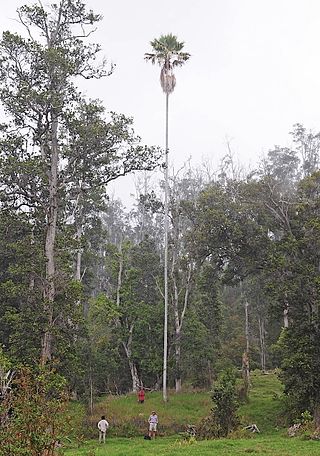
Pritchardia schattaueri, the lands of papa pritchardia or Schattauer's loulu, is a species of palm tree in the genus Pritchardia that is endemic to mixed mesic forests on the southwestern part of island of Hawaiʻi, near Kona. It is officially listed as a Critically endangered species.
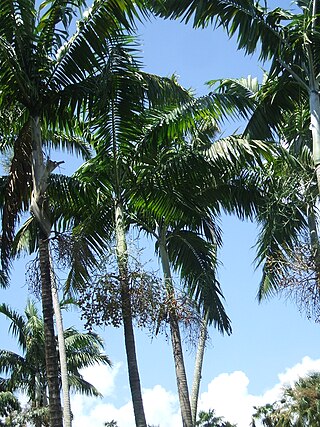
Veitchia is a genus of flowering plant in the family Arecaceae.

Bobea is a genus of flowering plants in the family Rubiaceae. All species in this genus are endemic to Hawaii. Bobea was named for Jean-Baptiste Bobe-Moreau by Charles Gaudichaud-Beaupré in 1830 in his book Voyage de l'Uranie.
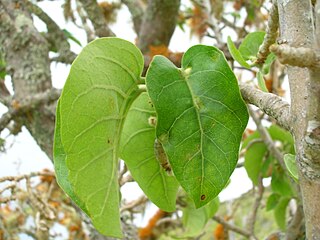
Nothocestrum is a genus of flowering plants in the nightshade family, Solanaceae. It contains four species of large shrubs or small trees that are endemic to Hawaii, where they are known as ʻaiea.

Santalum freycinetianum, the forest sandalwood, Freycinet sandalwood, or ʻIliahi, is a species of flowering tree in the European mistletoe family, Santalaceae, that is endemic to the Hawaiian Islands. Its binomial name commemorates Henri Louis Claude de Saulces de Freycinet, a 19th-century French explorer. ʻIliahi inhabits dry, coastal mesic, mixed mesic, and wet forests on Oʻahu, Kauaʻi, Lānaʻi, Maui, and Molokaʻi at elevations of 250–950 m (820–3,120 ft). It grows in areas that receive 500–3,800 mm (20–150 in) of annual rainfall. Like other members of its genus, ʻiliahi is a root hemi-parasite, deriving some of its nutrients from the host plant; common hosts include koa, koaiʻa, and ʻaʻaliʻi.

Pritchardia beccariana, the Kilauea pritchardia, or Beccari's loulu, is a species of palm tree in the genus Pritchardia that is endemic to wet forests on the eastern part of the island of Hawaiʻi, near Hilo.
Conchopus is a genus of flies in the family Dolichopodidae. It is distributed in Japan, China, Taiwan, the Hawaiian Islands, and Wake Island. The species Conchopus borealis is also an introduced species in North America and South America. Members of the genus live exclusively in the intertidal zone of rocky shores. The genus is sometimes considered a synonym of Thambemyia, but is considered a valid genus by some authors.
















